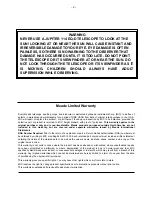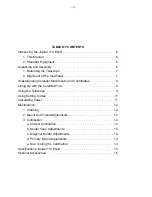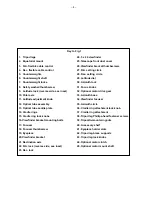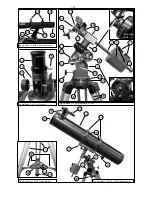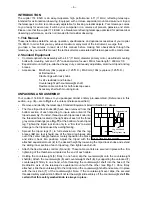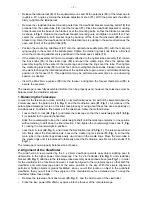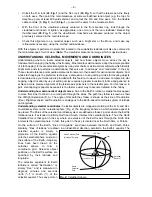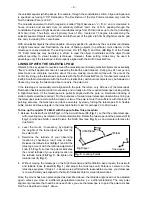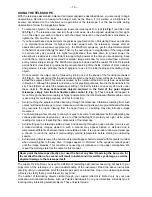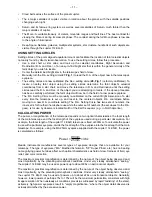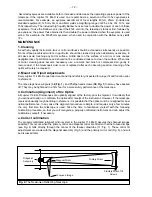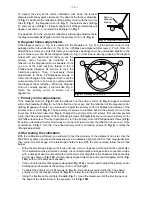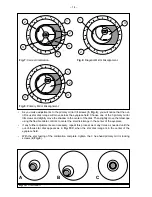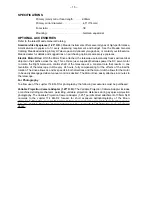
– 10 –
USING THE TELESCOPE
With the telescope assembled, balanced and polar aligned as described above, you are ready to begin
observations. Decide on an easy-to-find object such as the Moon, if it is visible, or a bright star to
become accustomed to the functions and operations of the telescope. For the best results during
observations, follow the suggestions below:
•
To center an object in the main telescope, loosen the telescope’s R.A. lock (22, Fig. 1) and Dec. lock
(23, Fig. 1). The telescope can now turn freely on its axes. Use the aligned viewfinder to first sight-
in on the object you wish to observe; with the object centered on the viewfinder’s crosshairs, re-
tighten the R.A. and Dec. locks.
•
If you have purchased an assortment of eyepieces (see Section G on Calculating Power and Section
J on Optional Accessories for higher and lower powers with the telescope), always start an
observation with a low power eyepiece (e.g., the MA 25mm eyepiece); get the object well-centered
in the field of view and sharply focused. Then try the next step up in magnification. If the image starts
to become fuzzy as you work into higher magnifications, then back down to a lower power; the
atmospheric steadiness is not sufficient to support high powers at the time you are observing. Keep
in mind that a bright, clearly resolved but smaller image will show far more detail than a dimmer,
poorly resolved larger image. The MA 25mm eyepiece included with the Jupiter 114 EQ-D presents
a wide field of view, ideal for general astronomical observing of star fields, clusters of stars, nebulae,
and galaxies; it is also probably the best eyepiece to use in the initial finding and centering of any
object.
•
Once centered, the object can be focused by turning one of the knobs of the focusing mechanism
(31, Fig. 1). You will notice that the astronomical object in the field of view will begin to slowly move
across the eyepiece field. This motion is caused by the rotation of the Earth on its axis, as described
in Section C, although the planets and stars, are, for practical purposes, fixed in their positions in the
sky. The platform on which the telescope is sitting ( the Earth) rotates once every 24 hours under
these objects. To keep astronomical objects centered in the field of the polar aligned
telescope, simply turn the R.A. flexible cable control (3, Fig. 1). These objects will appear to
move through the field more rapidly at higher powers. Note that the Declination flexible cable control
is used only for centering purposes, and not for tracking.
•
Avoid touching the eyepiece while observing through the telescope. Vibrations resulting from such
contact will cause the image to move. Likewise, avoid observing sites where ground-based vibrations
may resonate the tripod. Viewing from the upper floors of a building may also introduce image
movement.
•
You should allow a few minutes to allow your eyes to become “dark adapted” before attempting any
serious astronomical observations. Use a red filtered flashlight to protect your night vision when
reading star maps or inspecting the components of the telescope.
•
Avoid setting up the telescope inside a room and observing through an open window (or worse yet,
a closed window). Images viewed in such a manner may appear blurred or distorted due to
temperature differences between inside and outside air. Also, it is a good idea to allow your telescope
a chance to reach the ambient (surrounding) outside temperature before starting an observing
session.
•
Avoid viewing objects low on the horizon–objects will appear better resolved with far greater contrast
when viewed higher in the sky. Also, if images appear to “shimmer” in the eyepiece–reduce power
until the image steadies. This condition is caused by air turbulence in the upper atmosphere. We
repeat the warning stated at the outset of this manual:
Never point the telescope directly at or near the Sun at any time! Observing the Sun, even for
the smallest fraction of a second, will result in instant and irreversible eye damage, as well as
physical damage to the telescope itself.
The Jupiter 114 EQ-D may be used for a lifetime of rewarding astronomical observing, but basic to your
enjoyment of the telescope is a good understanding of the instrument. Read the above instructions
carefully until you understand all of the telescope’s parts and functions. One or two observing sessions
will serve to clarify these points forever in your mind.
The number of fascinating objects visible through your Jupiter reflector is limited only by your own
motivation. Astronomical software, such as Polaris’s AstroSearch, or a good star atlas, will assist you in
locating many interesting celestial objects. These objects include:


